If you can visit only one castle in the Rhine Valley, make it Rheinfels Castle (Burg Rheinfels in German). This was once the mightiest of the Rhine River castles and is easy to visit by train or riverboat.
Make the most of your time there with my comprehensive guide to visiting Burg Rheinfels. Based on my visit as part of a Rhine Valley itinerary, it has all you need to know about how to get there and what to see.

Some articles on this website contain affiliate links. This means that I may earn a small commission if you make a purchase through these links. As an Amazon Associate, I earn from qualifying purchases. Read the full disclosure here.
Rheinfels Castle is 100% Worth Visiting
Rheinfels Castle is the biggest castle on the Rhine and one of the best preserved.
You will love this castle if you are a history buff or architecture enthusiast. It has a long and rich history, dating back to the 13th Century, and is a superb example of a medieval fortress. Many of its original features are still intact, including its walls, towers and gates.
Thanks to its elevated position in the heart of the Rhine Valley, views from the castle over the river and across the surrounding landscape are magnificent.
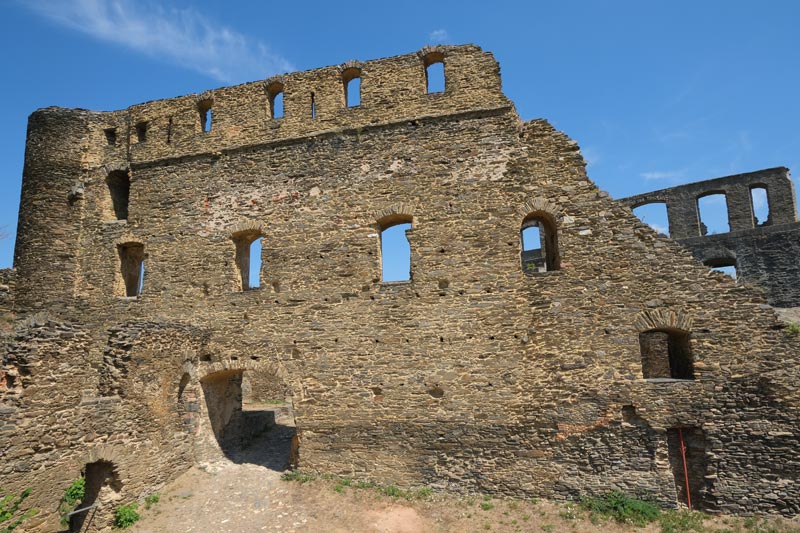
A Short History of Rheinfels Castle
Built in 1245 by Count Diether V. von Katzenelnbogen, Rheinfels Castle ruled the river for over 500 years. Like most other castles on the Rhine, Burg Rheinfels guarded a medieval toll station which extracted levies from passing boats.
Over the centuries, the castle was expanded and fortified by various owners, eventually covering five times its current area. When the House of Katzenelnbogen died off in 1479, Burg Rheinfels passed to the House of Hesse.
Rheinfels Castle withstood a two-year siege by a coalition of local towns (who were majorly hacked off by Rhine toll price hacks), and another by 28,000 of Louis XIV’s troops during the Nine Years War in 1692. It eventually fell to the French in 1794 who succeeded in ensuring that it was never used as a fortress again.
The castle remained an abandoned ruin until it was restored in the 20th Century.
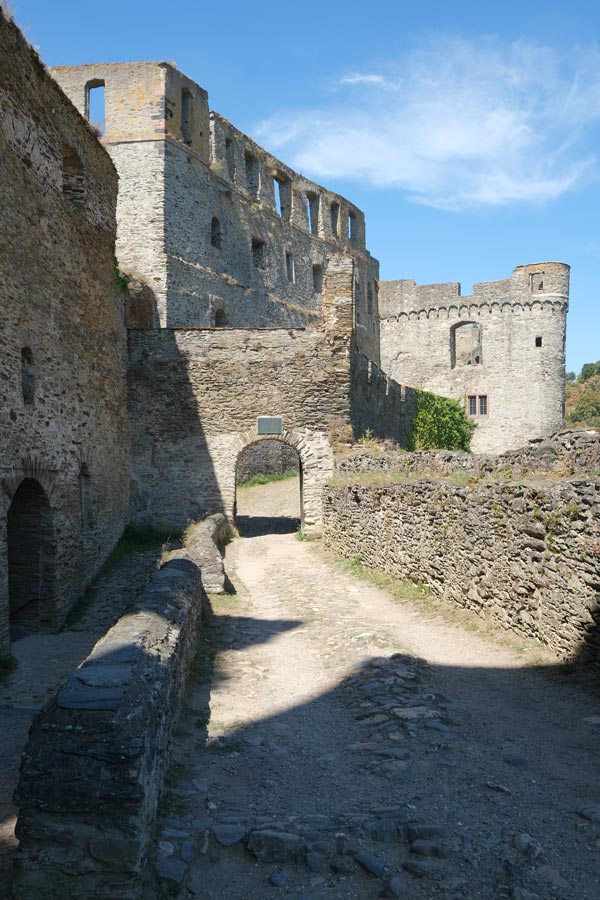
How to Visit Burg Rheinfels
Opening hours: The castle is open daily from April to November from 9 am to 6 pm (last admission at 5 pm). Reduced opening times apply in the winter months. Check here for current information.
Admission fee applies. In 2024, it costs €6 for an adult to visit Rheinfels Castle.
Guided tour or self-guided visit?
You can visit Rheinfels Castle on a guided tour or self-guided tour (this is what I did).
Castle staff run the guided tours three times a day on Saturdays, Sundays and public holidays. There is no need to pre-book.
The advantage of joining a guided tour is that you can visit parts of the castle that are not accessible otherwise. When I visited, guided tours of Rheinfels Castle were in German only.
However, there’s a lot to be said for absorbing the ambience of these castle ruins at your own pace. Pick up a map with a self-guided tour at the entrance.
Allow at least one hour to visit Rheinfels Castle.
What to See There
Prepare to let your imagination run free. Much of the joy of visiting Rheinfels Castle lies in simply roaming around its wonderfully evocative ruins which offer tantalising glimpses into its long history.
But for a slightly more structured visit, make your way towards these castle highlights:
- Museum
- Inner Castle Courtyard
- High Battery and Clock Tower
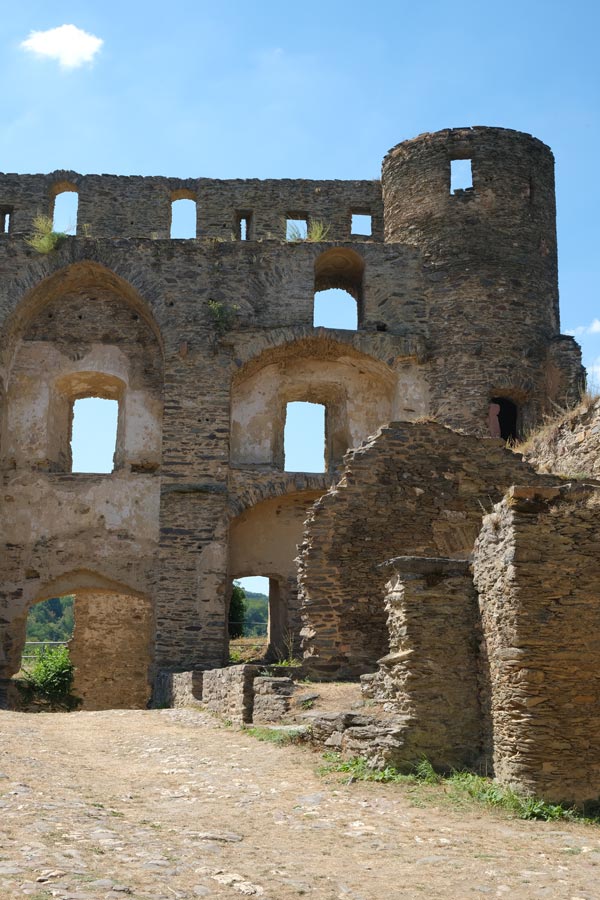
Rheinfels Castle Museum
Housed in the only finished room of the castle, this absorbing museum provides an overview of its history. There are well-presented exhibits with good English descriptions including a model of the castle as it was before Louis XIV’s troops had their way with it.
As a nerdy pharmacist, I particularly liked the museum’s lower level, which is home to the castle pharmacy.
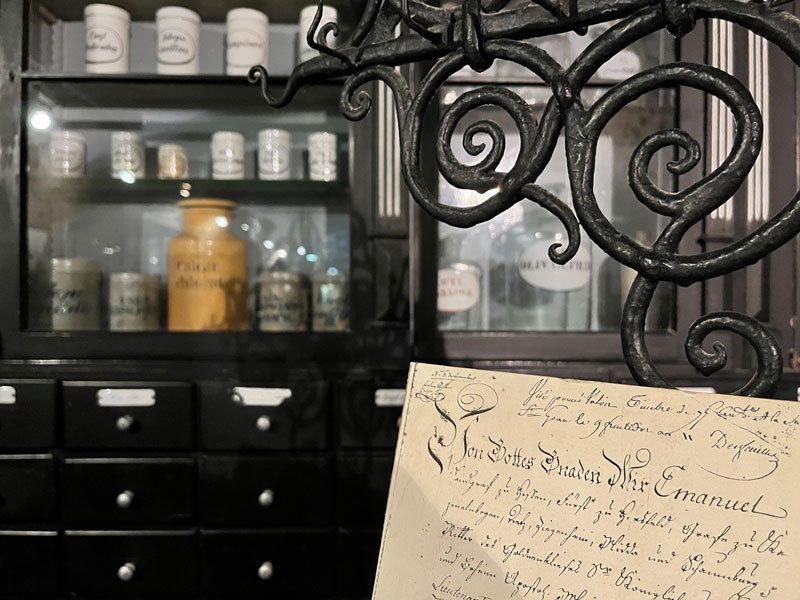
Inner Castle Courtyard
Once upon a time, the castle encircled this courtyard. It held a bakery, pharmacy (of course), herb garden, brewery (essential), well and livestock. All that you needed in the event of a siege.
From the courtyard of Burg Rheinfels, there are sensational views across the Gründelbach valley.
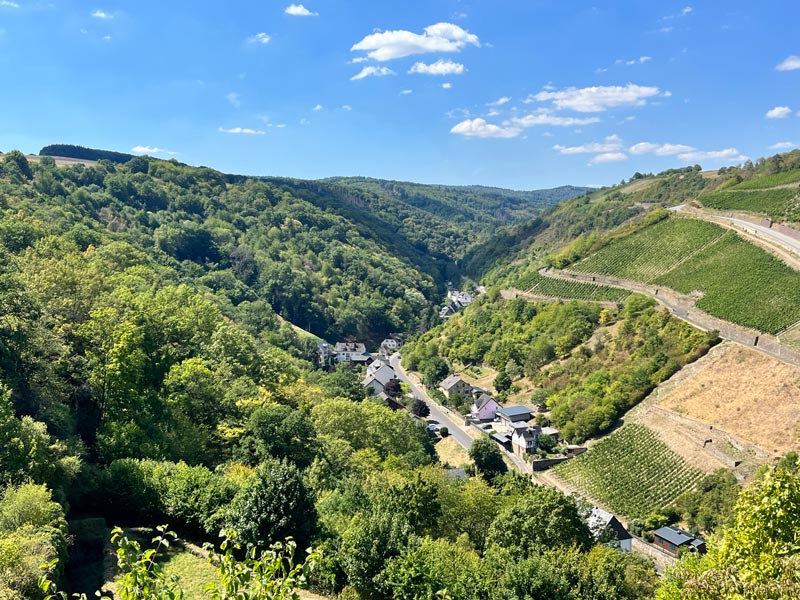
High Battery and Clock Tower
For another magnificent view, make your way along the High Battery, a defensive gallery with wide openings for armed gunners, to the Clock Tower. Standing at its original height of 21 meters, this is the best vantage point for views over the Loreley Valley.
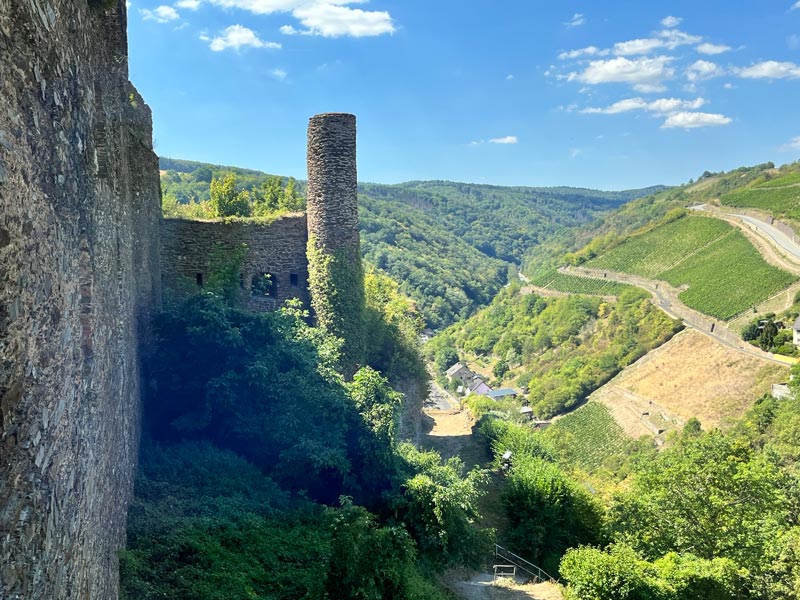
Cellar
When I visited Rheinfels Castle, the only way to see its cellar was on a guided tour.
This Grosser Keller was essentially a huge pantry. At its rear, an arch leads to what would have been the wine cellar.
How to Get to Rheinfels Castle
Rheinfels Castle is perched on a hilltop above the village of St. Goar (Sankt Goar) on the western side (left bank) of Germany’s Rhine River. The regional hubs are Koblenz to the north, and Mainz to the south.
You can get to Rheinfels Castle via St. Goar by train, boat or car.
By train
St. Goar is easily accessible by rail and its train station is in the town centre. It is on the super scenic line that connects Koblenz and Mainz to Cologne, Frankfurt and beyond.
You can check train times and prices here.
By boat
I travelled from my Rhine home base of Boppard to Burg Rheinfels on a scheduled Rhine riverboat service to St. Goar operated by Köln-Düsseldorfer (KD). It was a superb leisurely journey, taking 90 minutes to travel there and an hour for the faster return downstream journey.
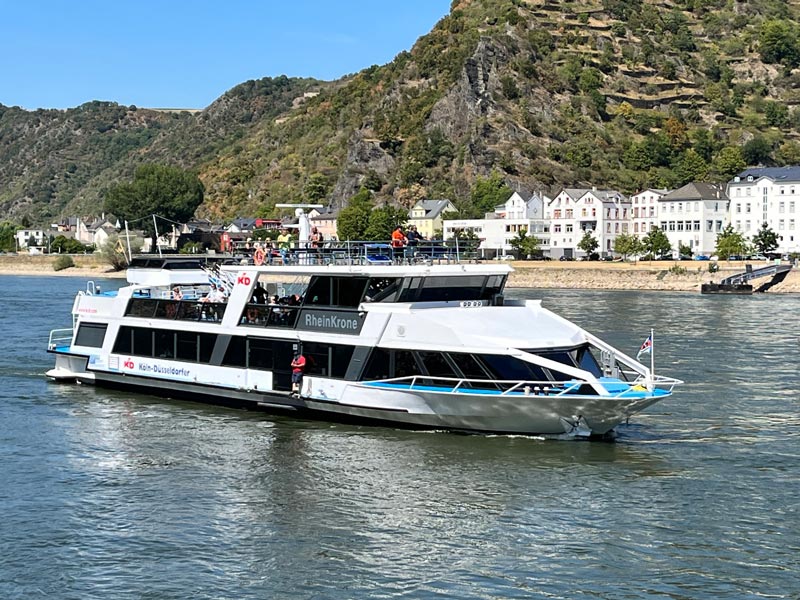
By car
If you are renting a car, you can reach St. Goar by autobahn from either Frankfurt in the south or Cologne to the north. The B9 road cradles the curves of the Rhine River between Koblenz and Bingen.
There is a limited number of paid parking spaces at the castle.
Getting from St. Goar to Rheinfels Castle
You can either walk from St. Goar to Burg Rheinfels or jump on the shuttle bus.
On foot
I followed the nature route that winds through terraces of trees from St. Goar to Rheinfels Castle. White-on-red signs for “Burg Rheinfels” will show you the way and the walk takes 15 minutes.
By shuttle bus
A shuttle bus (#699) leaves the centre of St. Goar for Rheinfels Castle every 30 minutes.
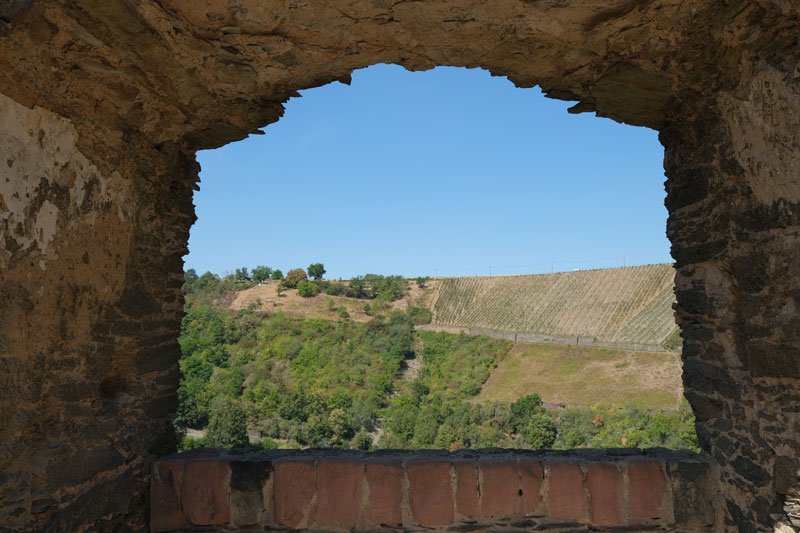
Where to Eat
For a cup of coffee with a view, head next door to Schlosshotel Rheinfels, one of the Rhine Valley’s finest hotels.
For a (slightly) broader choice of places to eat, walk back down to St. Goar. I can recommend Café St. Goar on the main drag (Heerstrasse).
Places to Visit Near Rheinfels Castle
Whilst it is a pleasant Rhine town, St. Goar won’t have much to detain you. Heerstrasse runs between the riverfront and the road leading to the castle and is lined with a small number of forgettable shops.
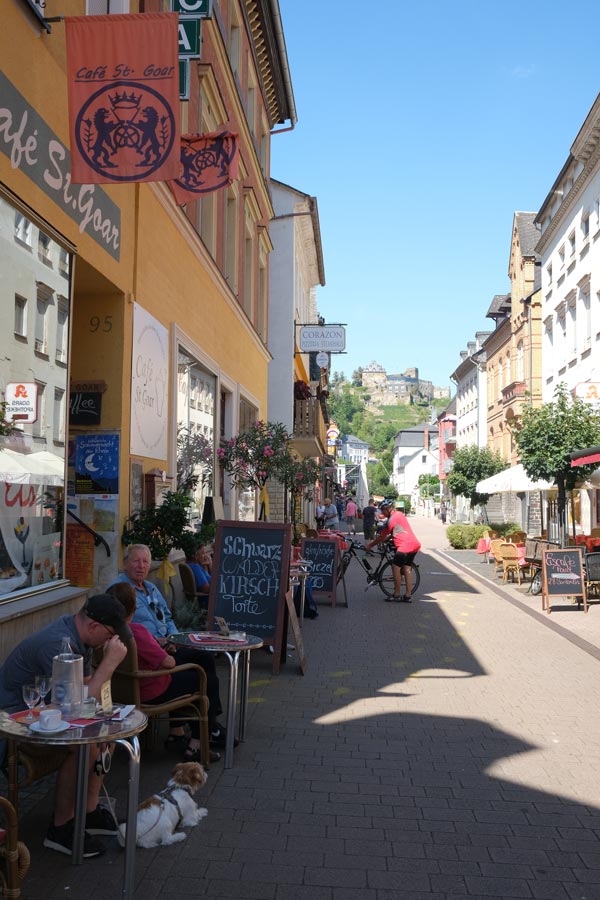
Boppard, Bacharach and Oberwesel are better bets. All three are connected to St. Goar by train or boat.
Across the river from St. Goar are two of the prettiest castles on the Rhine: Burg Maus and Burg Katz, immortalised by the painter JMW Turner. Although you can’t normally visit these castles, you are treated to a great view of them from a Rhine river boat.
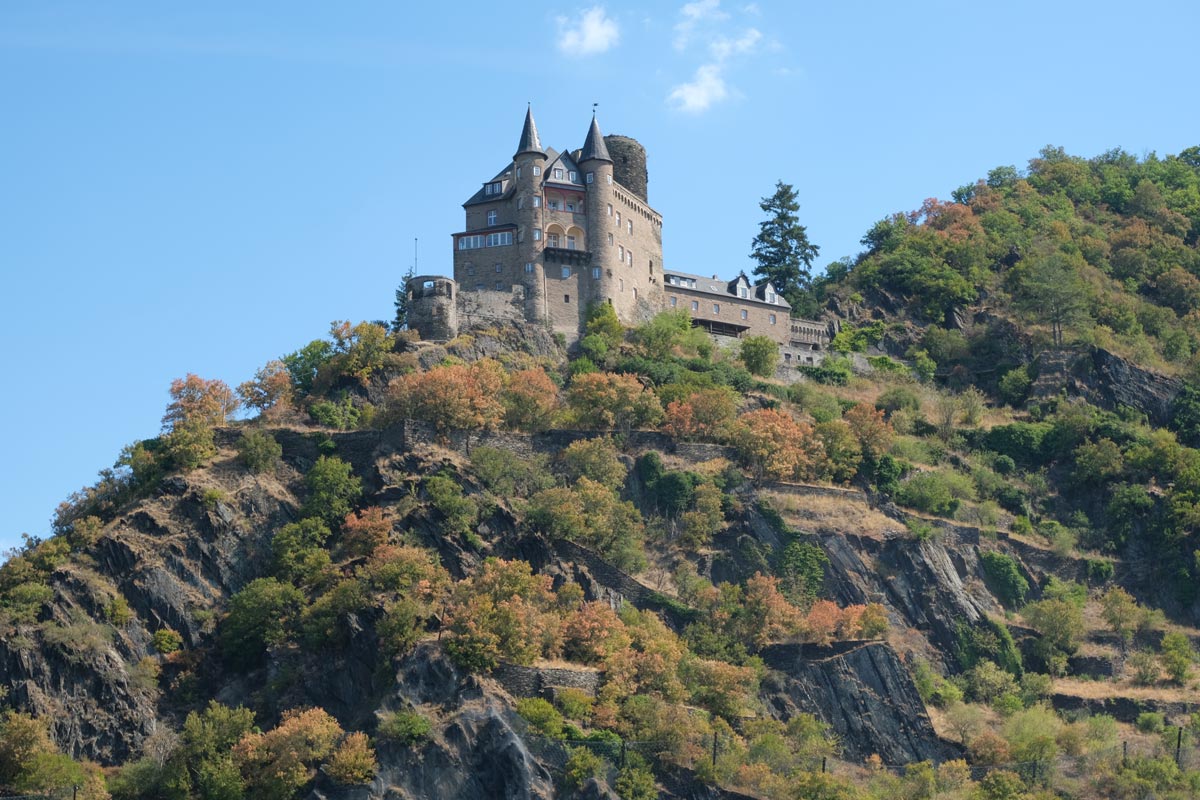
Downstream of Rheinfels Castle are the Hostile Brothers castles of Liebenstein and Sterrenberg, also easily visible from a Rhine River cruise. Their nickname refers to a 16th-century myth saying that bad blood between the brothers after they fell in love with the same woman caused their castles to fall. As for the woman; she did a runner.
The iconic Loreley Rock is just over a mile south of St. Goar. Legend says that it was from here that a lovelorn siren enticed fishermen to their doom.
And That’s a Wrap!
Enjoy Burg Rheinfels! If you have found this article helpful, check out my other Rhine Valley guides:
- 12 Best Things to Do in Boppard, Germany
- 16 Unmissable Things to Do in Bacharach, Germany & Beyond
- 12 Wonderful Things to Do in Oberwesel, Germany & Beyond
- How to Explore Germany’s Romantic Rhine Valley: Itinerary & Planning Tips

About Bridget
Bridget Coleman has been a passionate traveller for more than 30 years. She has visited 70+ countries, most as a solo traveller.
Articles on this site reflect her first-hand experiences.
To get in touch, email her at hello@theflashpacker.net or follow her on social media.
